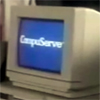The CompuServe dial-up service played an early role in the development
of online communications. It was first offered to the public on
September 24, 1979.
Although it is often forgotten, CompuServe helped share some of the first online newspapers. The following video shows what it was like to read CompuServe’s “electronic journalism.”
You could read an online newspaper as early as July 1, 1980. All a
reader needed was a computer, such as an Apple II or the TRS-80
desktop model, and a modem with access to the online CompuServe
dial-up service.
The first newspaper to go online was The Columbus Dispatch. It was
part of a unique CompuServe and Associated Press experiment about the
potential of online papers. Eventually other AP member
newspapers were part of the project, including the Washington Post,
The New York Times, The Minneapolis Star Tribune, The San Francisco
Chronicle, The San Francisco Examiner, the Los Angeles Times, The
Virginian-Pilot, The Middlesex News, the St. Louis Post-Dispatch, and
the Atlanta Journal-Constitution.
Although it ended in 1982, the CompuServe/AP experiment became a
crucial step in the history of online journalism.
And now a quick commercial from CompuServe:
CompuServe also became one of the largest systems for electronic bulletin board (BBS) access. This video describes how online access worked with
CompuServe and other dial-up services such as The Source.






